Sustainable Development Goals in the Business Sphere: A Bibliometric Review
Abstract
1. Introduction
2. Literature Reviews in the Field of SDGs in the Business Context
| Authors | Journal | Research Objective | Type of Review | Period Analyzed | Papers Analyzed |
|---|---|---|---|---|---|
| Di Vaio et al. [25] | Journal of Business Research | The research explores the relationship between artificial intelligence and rapid advances in machine learning to achieve sustainable resource management in line with the SDGs. | Bibliometric analysis | 1990–2019 | 73 |
| Pizzi et al. [28] | Journal of Cleaner Production | This review systematically examines, using bibliometric and systematic literature review methods, the scientific knowledge on the SDGs and the business sector. | Bibliometric and systematic review | 2012–2019 | 266 |
| Ye et al. [29] | Journal of Cleaner Production | The study reviews the literature on the link between CSR and sustainable development within the framework of the SDGs developed by the United Nations. | Bibliometric analysis | 1997–2019 | 1006 |
| Alvino et al. [30] | Journal of Intellectual Capital | The article analyses whether intellectual capital, through the application of knowledge management processes, can influence business orientation towards the creation of sustainable business models and, therefore, the achievement of the SDGs. | Systematic review | 1990–2019 | 45 |
| Di Vaio et al. [31] | Meditari Accountancy Research | The aim of this article is to provide a comprehensive and systematic overview of the academic literature focusing on the role of integrated reporting and integrated thinking in achieving sustainable business models for the SDGs. | Bibliometric analysis | 1990–2019 | 60 |
| Meseguer-Sánch et al. [32] | Sustainability | This research aims to analyze the relationship between the concepts of CSR and CS in order to understand the advances in current scientific production as well as their link with the SDGs. | Bibliometric analysis | 2001–2020 | 3079 |
| Agrawal et al. [33] | Business Strategy and the Environment | The research aims to analyze the literature on the adoption and implementation of the SDGs in companies’ supply chain activities. | Bibliometric analysis | 2015–2021 | 144 |
| Del Giudice et al. [34] | Maritime Policy and Management | This work aims to investigate through a barometric analysis whether digitalization and new technologies can help in the creation of sustainable business models and, therefore, the fulfilment of the SDGs. | Bibliometric analysis | 1969–2020 | 132 |
| Garrido-Ruso et al. [26] | Sustainability | This paper aims to determine the scope of the existing literature on the role of organizations in contributing to the advancement of the SDGs. | Bibliometric analysis | 2015–2021 | 543 |
| Jan et al. [35] | Environmental Science and Pollution Research | The research reviews the academic literature concerning the effect of CS on sustainable development and the achievement of the SDGs. | Bibliometric analysis | 2005–2021 | 1214 |
| Lee et al. [27] | Sustainability | The research aims to deepen through a systematic review the current state of sustainability and SDG studies in business and management disciplines. | Systematic review | 2015–2021 | 237 |
| Kurek et al. [37] | Sustainability | The aim of this article is to improve the understanding of how design thinking and its set of tools and methods contribute to the creation and innovation of sustainable business models and to the achievement of the SDGs. | Bibliometric and systematic review | 2002–2021 | 371 |
3. Methodology
4. Results and Discussion
5. Conclusions
Author Contributions
Funding
Institutional Review Board Statement
Informed Consent Statement
Data Availability Statement
Conflicts of Interest
References
- Van Zanten, J.; van Tulder, R. Improving companies’ impacts on sustainable development: A nexus approach to the SDGS. Bus. Strateg. Environ. 2021, 30, 3703–3720. [Google Scholar] [CrossRef]
- Lukin, E.; Krajnović, A.; Bosna, J. Sustainability strategies and achieving SDGs: A comparative analysis of leading companies in the automotive industry. Sustainability 2022, 14, 4000. [Google Scholar] [CrossRef]
- Schramade, W. Investing in the UN sustainable development goals: Opportunities for companies and investors. J. Appl. Corp. Financ. 2017, 29, 87–99. [Google Scholar] [CrossRef]
- Lassala, C.; Orero-Blat, M.; Ribeiro-Navarrete, S. The financial performance of listed companies in pursuit of the Sustainable Development Goals (SDG). Econ. Res. -Ekon. Istraž. 2021, 34, 427–449. [Google Scholar] [CrossRef]
- Ionașcu, E.; Mironiuc, M.; Anghel, I.; Huian, M. The involvement of real estate companies in sustainable development—An analysis from the SDGs reporting perspective. Sustainability 2020, 12, 798. [Google Scholar] [CrossRef]
- Jimenez, D.; Franco, I.; Smith, T. A review of corporate purpose: An approach to actioning the sustainable development goals (SDGs). Sustainability 2021, 13, 3899. [Google Scholar] [CrossRef]
- Mishra, L. Corporate social responsibility and sustainable development goals: A study of Indian companies. J. Public Aff. 2021, 21, e2147. [Google Scholar] [CrossRef]
- Kurz, R. UN SDGs: Disruptive for companies and for universities? In The Future of the UN Sustainable Development Goals: Business Perspectives for Global Development in 2030; Springer International Publishing: Cham, Switzerland, 2019; pp. 279–290. [Google Scholar]
- Pillai, K.; Slutsky, P.; Wolf, K.; Duthler, G.; Stever, I. Companies’ accountability in sustainability: A comparative analysis of SDGs in five countries. Sustain. Dev. Goals Asian Context 2017, 19, 85–106. [Google Scholar]
- Blagov, Y.; Petrova-Savchenko, A. The transformation of corporate sustainability model in the context of achieving the UN SDGs: Evidence from the leading Russian companies. Int. J. Bus. Soc. 2021, 21, 307–321. [Google Scholar] [CrossRef]
- Rubio-Mozos, E.; García-Muiña, F.; Fuentes-Moraleda, L. Sustainable strategic management model for hotel companies: A multi-stakeholder proposal to “walk the talk” toward SDGS. Sustainability 2020, 12, 8652. [Google Scholar] [CrossRef]
- Marco-Lajara, B.; Zaragoza-Sáez, P.; Martínez-Falcó, J.; Sánchez-García, E. Does green intellectual capital affect green innovation performance? Evidence from the Spanish wine industry. Br. Food J. 2022. ahead-of-print. [Google Scholar] [CrossRef]
- Marco-Lajara, B.; Zaragoza-Sáez, P.; Martínez-Falcó, J.; Ruiz-Fernández, L. The effect of green intellectual capital on green performance in the Spanish wine industry: A structural equation modeling approach. Complexity 2022, 2022, 6024077. [Google Scholar] [CrossRef]
- Marco-Lajara, B.; Sánchez-García, E.; Martínez-Falcó, J.; Poveda-Pareja, E. Regional Specialization, Competitive Pressure, and Cooperation: The Cocktail for Innovation. Energies 2022, 15, 5346. [Google Scholar] [CrossRef]
- Fuentes-Fernández, R.; Martínez-Falcó, J.; Sánchez-García, E.; Marco-Lajara, B. Does Ecological Agriculture Moderate the Relationship between Wine Tourism and Economic Performance? A Structural Equation Analysis Applied to the Ribera del Duero Wine Context. Agriculture 2022, 12, 2143. [Google Scholar] [CrossRef]
- Martínez-Falcó, J.; Sánchez-García, E.; Millan-Tudela, L.; Marco-Lajara, B. The Role of Green Agriculture and Green Supply Chain Management in the Green Intellectual Capital–Sustainable Performance Relationship: A Structural Equation Modeling Analysis Applied to the Spanish Wine Industry. Agriculture 2023, 13, 425. [Google Scholar] [CrossRef]
- Marco-Lajara, B.; Martínez-Falcó, J.; Millán-Tudela, L.; Sánchez-García, E. Analysis of the structure of scientific knowledge on wine tourism: A bibliometric analysis. Heliyon 2023, 9, e13363. [Google Scholar] [CrossRef] [PubMed]
- Sánchez-García, E.; Marco-Lajara, B.; Seva-Larrosa, P.; Martínez-Falcó, J. Driving Innovation by Managing Entrepreneurial Orientation, Cooperation and Learning for the Sustainability of Companies in the Energy Sector. Sustainability 2022, 14, 16978. [Google Scholar] [CrossRef]
- Nechita, E.; Manea, C.; Nichita, E.; Irimescu, A.; Manea, D. Is financial information influencing the reporting on SDGs? Empirical evidence from central and eastern European chemical companies. Sustainability 2020, 12, 9251. [Google Scholar] [CrossRef]
- Muhmad, S.; Muhamad, R. Sustainable business practices and financial performance during pre-and post-SDG adoption periods: A systematic review. J. Sustain. Financ. Investig. 2021, 11, 291–309. [Google Scholar] [CrossRef]
- Orazalin, N.; Baydauletov, M. Corporate social responsibility strategy and corporate environmental and social performance: The moderating role of board gender diversity. Corp. Soc. Responsib. Environ. Manag. 2020, 27, 1664–1676. [Google Scholar] [CrossRef]
- Fallah Shayan, N.; Mohabbati-Kalejahi, N.; Alavi, S.; Zahed, M. Sustainable development goals (SDGs) as a framework for corporate social responsibility (CSR). Sustainability 2022, 14, 1222. [Google Scholar] [CrossRef]
- Abbas, J. Impact of total quality management on corporate green performance through the mediating role of corporate social responsibility. J. Clean. Prod. 2020, 242, 118458. [Google Scholar] [CrossRef]
- Gan, Y.; Li, D.; Robinson, N.; Liu, J. Practical guidance on bibliometric analysis and mapping knowledge domains methodology–A summary. Eur. J. Integr. Med. 2022, 56, 102203. [Google Scholar] [CrossRef]
- Di Vaio, A.; Palladino, R.; Hassan, R.; Escobar, O. Artificial intelligence and business models in the sustainable development goals perspective: A systematic literature review. J. Bus. Res. 2020, 121, 283–314. [Google Scholar] [CrossRef]
- Garrido-Ruso, M.; Aibar-Guzmán, B.; Monteiro, A. Businesses’ Role in the Fulfillment of the 2030 Agenda: A Bibliometric Analysis. Sustainability 2022, 14, 8754. [Google Scholar] [CrossRef]
- Lee, S.; Zhou, Y. The Outlook for Sustainable Development Goals in Business and Management: A Systematic Literature Review and Keyword Cluster Analysis. Sustainability 2022, 14, 11976. [Google Scholar] [CrossRef]
- Pizzi, S.; Caputo, A.; Corvino, A.; Venturelli, A. Management research and the UN sustainable development goals (SDGs): A bibliometric investigation and systematic review. J. Clean. Prod. 2020, 276, 124033. [Google Scholar] [CrossRef]
- Ye, N.; Kueh, T.; Hou, L.; Liu, Y.; Yu, H. A bibliometric analysis of corporate social responsibility in sustainable development. J. Clean. Prod. 2020, 272, 122679. [Google Scholar] [CrossRef]
- Alvino, F.; Di Vaio, A.; Hassan, R.; Palladino, R. Intellectual capital and sustainable development: A systematic literature review. J. Intellect. Cap. 2021, 22, 76–94. [Google Scholar] [CrossRef]
- Di Vaio, A.; Syriopoulos, T.; Alvino, F.; Palladino, R. “Integrated thinking and reporting” towards sustainable business models: A concise bibliometric analysis. Medit. Account. Res. 2021, 29, 691–719. [Google Scholar] [CrossRef]
- Meseguer-Sánchez, V.; Gálvez-Sánchez, F.; López-Martínez, G.; Molina-Moreno, V. Corporate social responsibility and sustainability. A bibliometric analysis of their interrelations. Sustainability 2021, 13, 1636. [Google Scholar] [CrossRef]
- Agrawal, R.; Majumdar, A.; Majumdar, K.; Raut, R.; Narkhede, B. Attaining sustainable development goals (SDGs) through supply chain practices and business strategies: A systematic review with bibliometric and network analyses. Bus. Strategy Environ. 2022, 31, 3669–3687. [Google Scholar] [CrossRef]
- Del Giudice, M.; Di Vaio, A.; Hassan, R.; Palladino, R. Digitalization and new technologies for sustainable business models at the ship–port interface: A bibliometric analysis. Marit. Policy Manag. 2022, 49, 410–446. [Google Scholar] [CrossRef]
- Jan, A.; Lai, F.; Siddique, J.; Zahid, M.; Ali, S. A walk of corporate sustainability towards sustainable development: A bibliometric analysis of literature from 2005 to 2021. Environ. Sci. Pollut. Res. 2022, 19, 1–12. [Google Scholar] [CrossRef]
- Clarivate. Web of Science Core Collection. 2022. Available online: https://clarivate.com/webofsciencegroup/solutions/web-of-science-core-collection/ (accessed on 2 February 2023).
- Kurek, J.; Brandli, L.; Leite Frandoloso, M.; Lange Salvia, A.; Mazutti, J. Sustainable Business Models Innovation and Design Thinking: A Bibliometric Analysis and Systematic Review of Literature. Sustainability 2023, 15, 988. [Google Scholar] [CrossRef]
- Clarivate. Operadores de Búsqueda. 2021. Available online: http://webofscience.help.clarivate.com/es-es/Content/search-operators.html (accessed on 2 February 2023).
- Clarivate. Reglas de Búsqueda. 2021. Available online: http://webofscience.help.clarivate.com/es-es/Content/search-rules.htm (accessed on 2 February 2023).
- Page, M.; McKenzie, J.; Bossuyt, P.; Boutron, I.; Hoffmann, T.; Mulrow, C.; Moher, D. The PRISMA 2020 statement: An updated guideline for reporting systematic reviews. Int. J. Surg. 2021, 88, 105906. [Google Scholar] [CrossRef]
- Moher, D.; Liberati, A.; Tetzlaff, J.; Altman, D.; Prisma Group. Preferred reporting items for systematic reviews and meta-analyses: The PRISMA statement. Int. J. Surg. 2010, 8, 336–341. [Google Scholar] [CrossRef]
- Rethlefsen, M.; Kirtley, S.; Waffenschmidt, S.; Ayala, A.; Moher, D.; Page, M.; Koffel, J. PRISMA-S: An extension to the PRISMA statement for reporting literature searches in systematic reviews. Syst. Rev. 2021, 10, 39. [Google Scholar] [CrossRef] [PubMed]
- van Eck, N.J.; Waltman, L. Software survey: VOSviewer, a computer program for bibliometric mapping. Scientometrics 2010, 84, 523–538. [Google Scholar] [CrossRef] [PubMed]
- Shah, S.; Lei, S.; Ali, M.; Doronin, D.; Hussain, S. Prosumption: Bibliometric analysis using HistCite and VOSviewer. Kybernetes 2020, 49, 1020–1045. [Google Scholar] [CrossRef]
- United Nations. Back to Our Common Future: Sustainable Development in the 21st Century (SD21) Project. 2012. Available online: https://sustainabledevelopment.un.org/content/documents/UN-DESA_Back_Common_Future_En.pdf (accessed on 2 February 2023).
- Bastida, R.; Molas, N. Aprovechar los ODS para aumentar el impacto social y medioambiental de las empresas. Harv. Deusto Bus. Rev. 2022, 318, 66–75. [Google Scholar]
- United Nations Division for Sustainable Development. Agenda 21. In United Nations Conference on Environment & Development. Izv. -Akad. Nauk. Seriya Geogr. 1992, 6. [Google Scholar] [CrossRef]
- Agirreazkuenaga, L. Education for Agenda 2030: What direction do we want to take going forward? Sustainability 2020, 12, 2035. [Google Scholar] [CrossRef]
- García-Meca, E.; Martínez-Ferrero, J.; Sánchez-Ballesta, J. El cumplimento de los ODS y sus efectos en la rentabilidad económica en la empresa cotizada española. Rev. Contab. Tribut. 2021, 19, 195–220. [Google Scholar] [CrossRef]
- Chassé, D. The roots of the millennium development goals: A framework for studying the history of global statistics. Hist. Soc. Res. 2016, 17, 218–237. [Google Scholar]
- Fritz, S.; See, L.; Carlson, T.; Haklay, M.; Oliver, J.; Fraisl, D.; West, S. Citizen science and the United Nations sustainable development goals. Nat. Sustain. 2019, 2, 922–930. [Google Scholar] [CrossRef]
- Barbero Vignola, G.; Acs, S.; Borchardt, S.; Sala, S.; Giuntoli, J.; Smits, P.; Marelli, L. Modelling for Sustainable Development Goals (SDGs): Overview of JRC Models; Publication Office of the European Union EU Science Hub-European Commission: Luxembourg, 2020. [Google Scholar]
- Koundouri, P.; Devves, S.; Plataniotis, A. Alignment of the European green deal, the sustainable development goals and the European semester process: Method and application. Theor. Econ. Lett. 2021, 11, 743–770. [Google Scholar] [CrossRef]
- Porter, M. Competitive advantage, agglomeration economies, and regional policy. Int. Reg. Sci. Rev. 1996, 19, 85–90. [Google Scholar] [CrossRef]
- Schaltegger, S.; Burritt, R. Corporate sustainability. In The International Yearbook of Environmental and Resource Economics; Edward Elgar Publishing: Cheltenham, UK, 2005; pp. 185–222. [Google Scholar]
- Carroll, A. Carroll’s pyramid of CSR: Taking another look. Int. J. Corp. Soc. Responsib. 2016, 1, 1–8. [Google Scholar] [CrossRef]
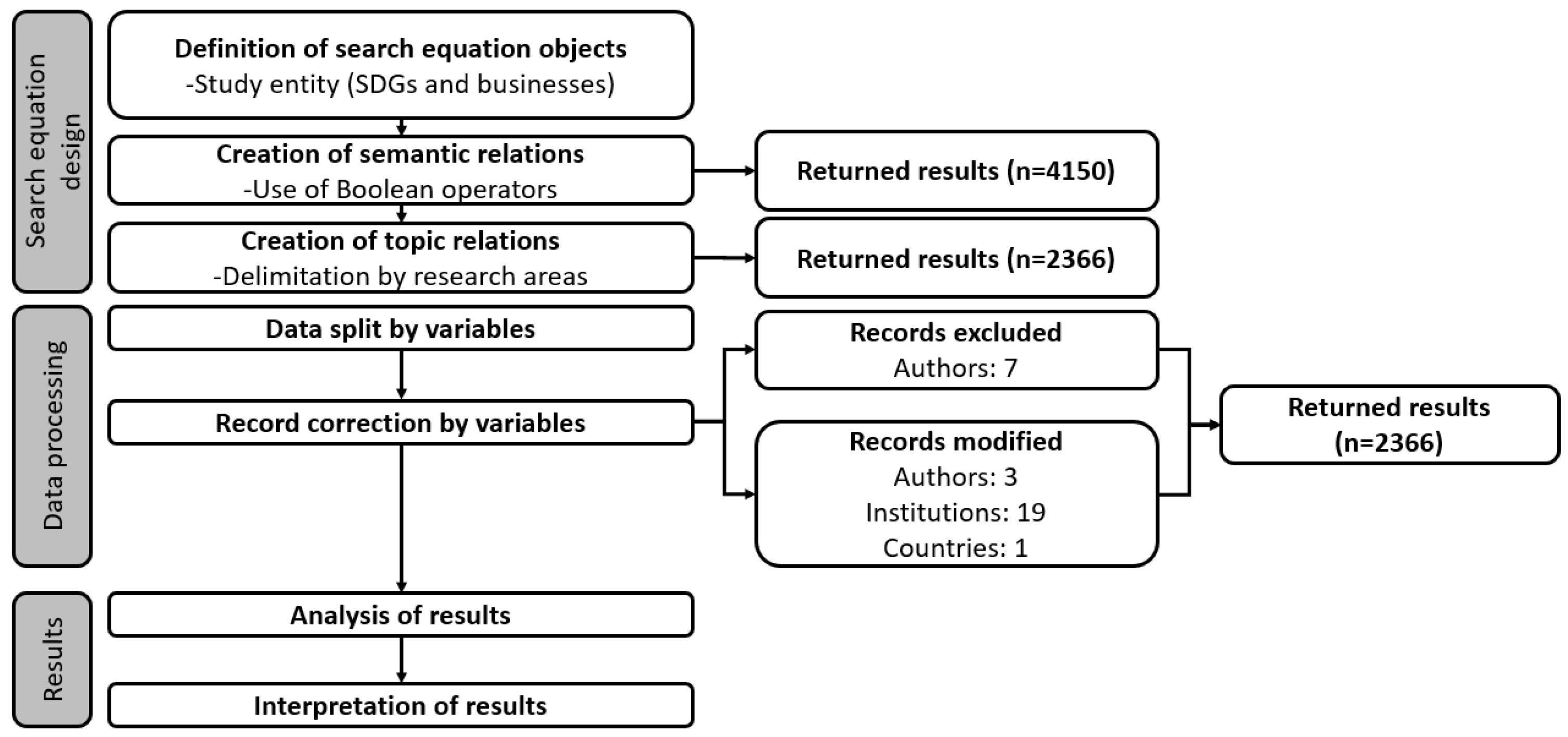
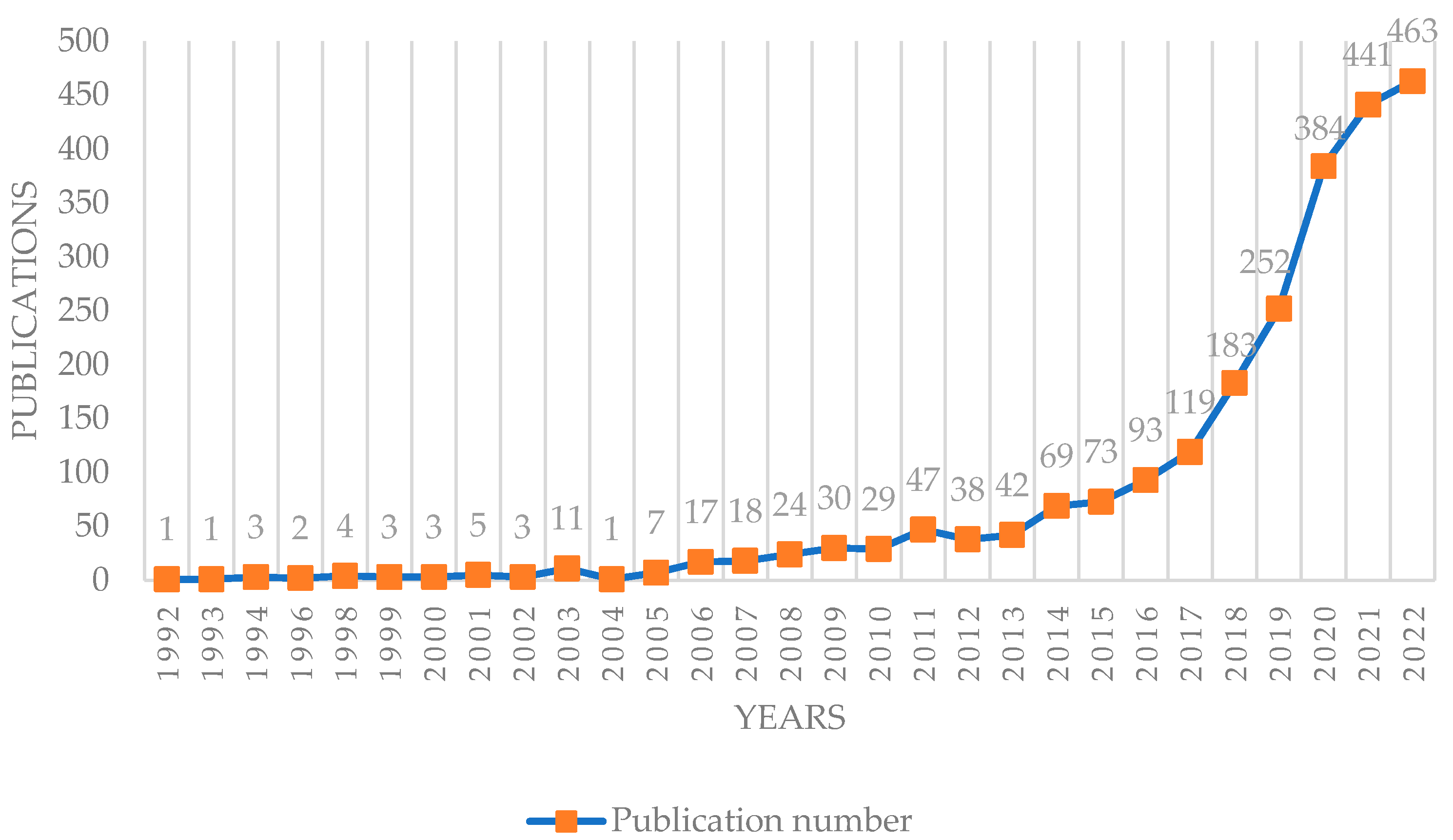
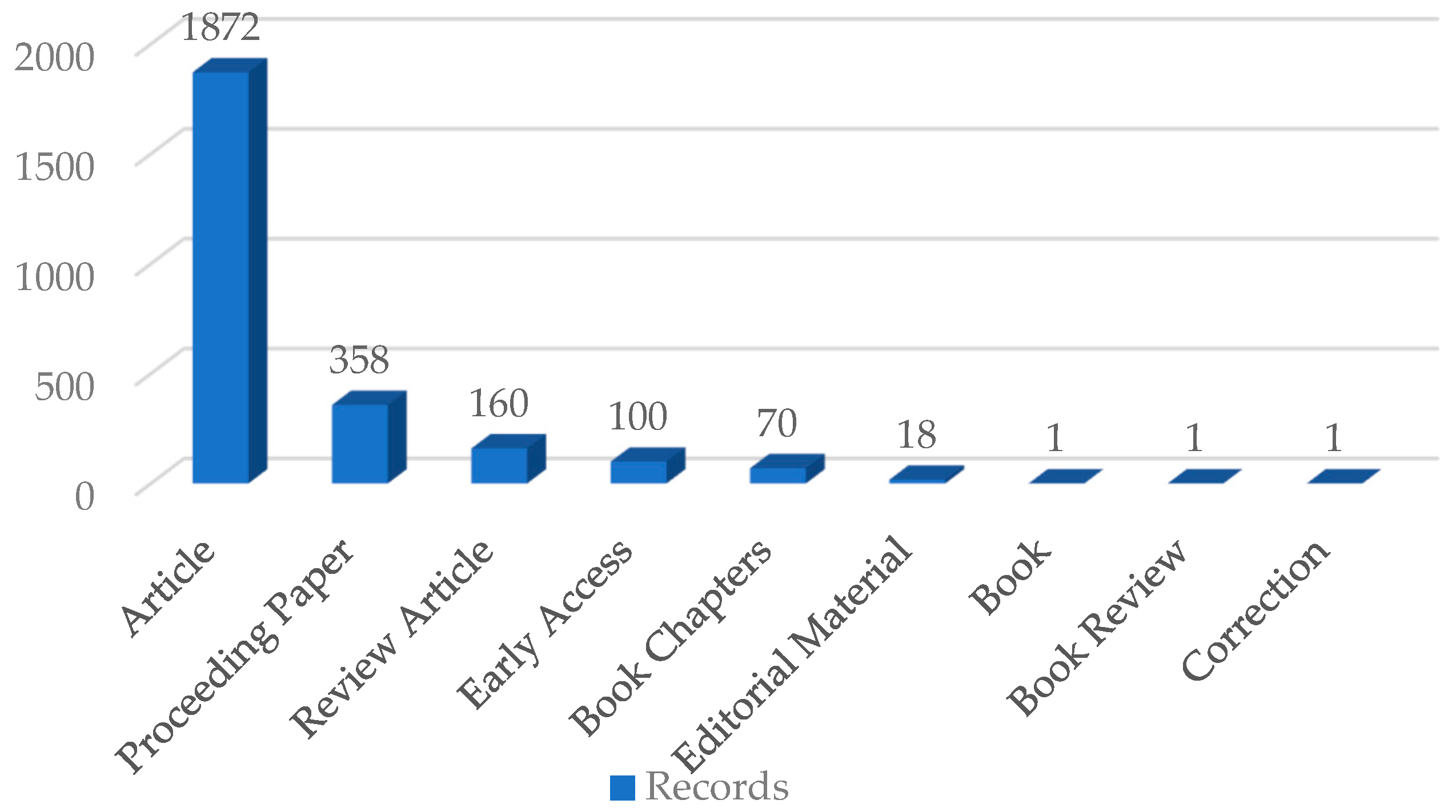
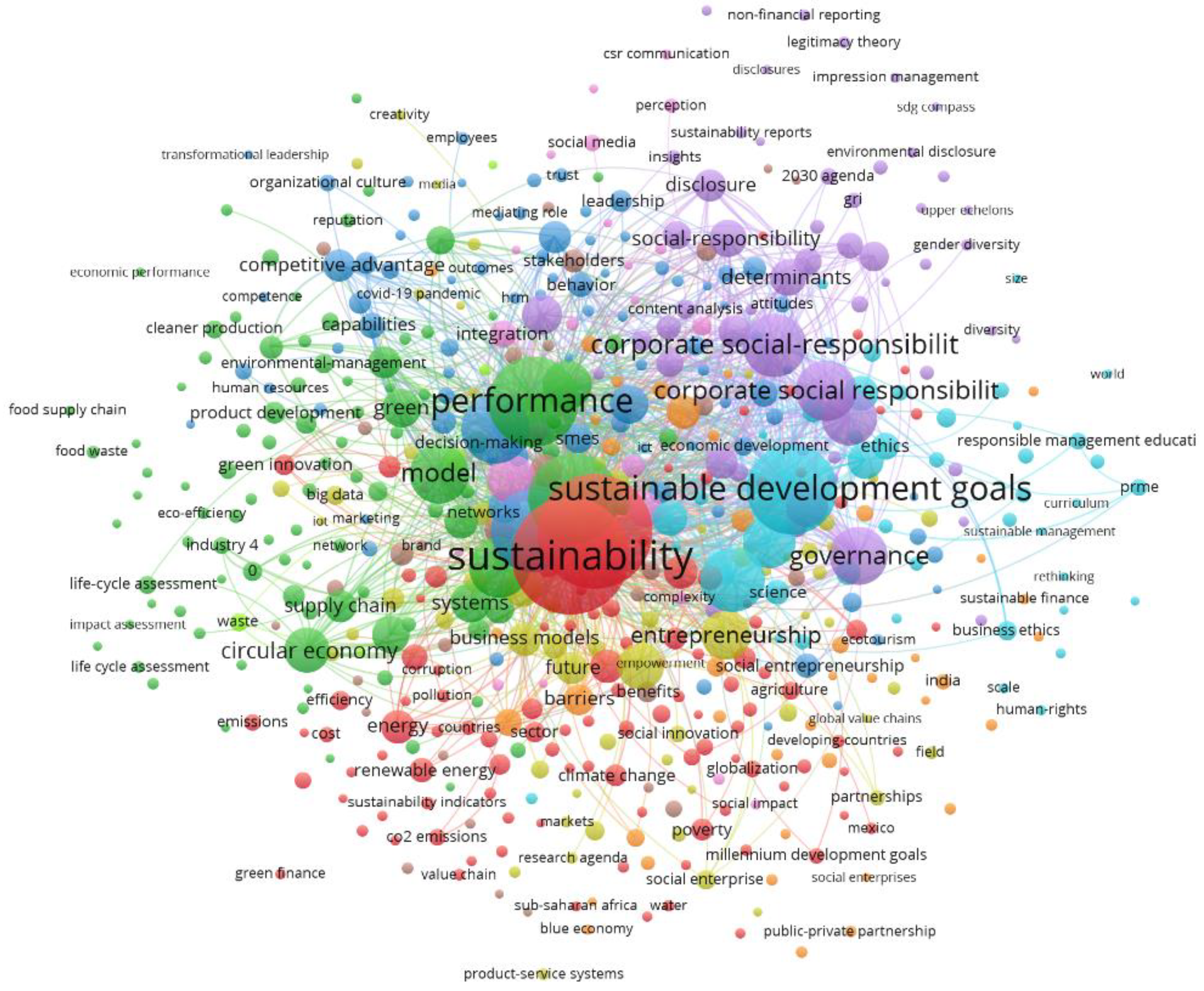
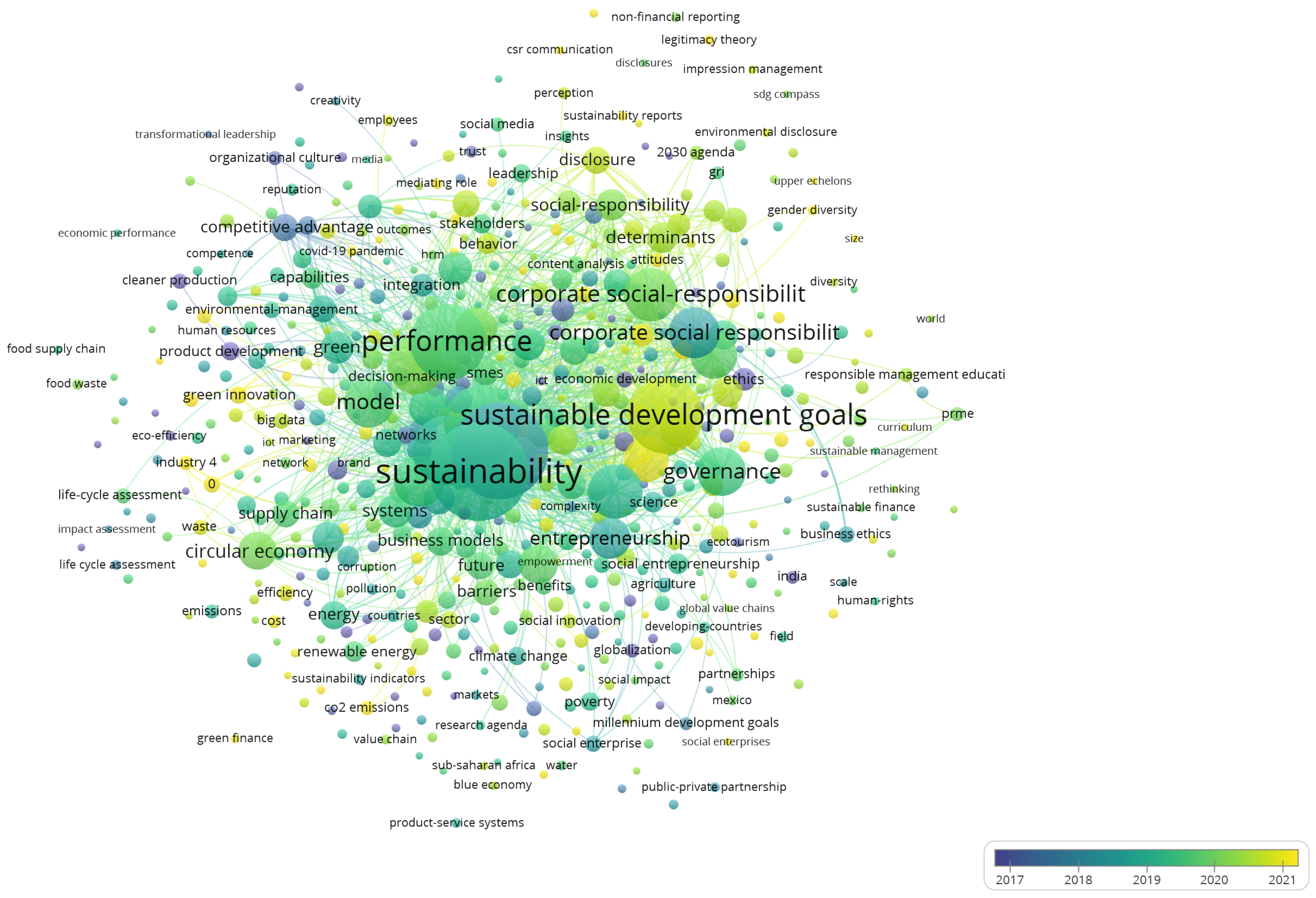

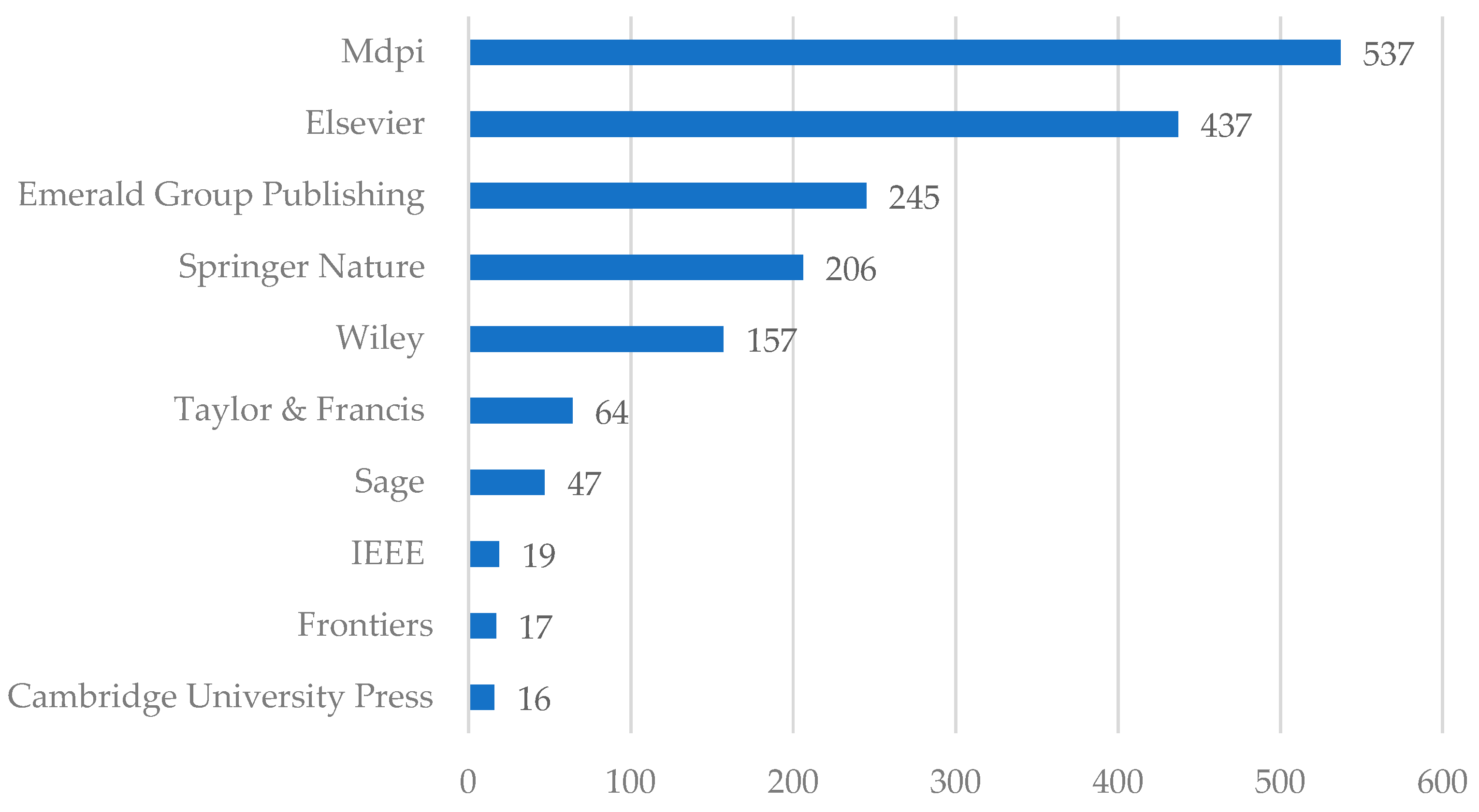
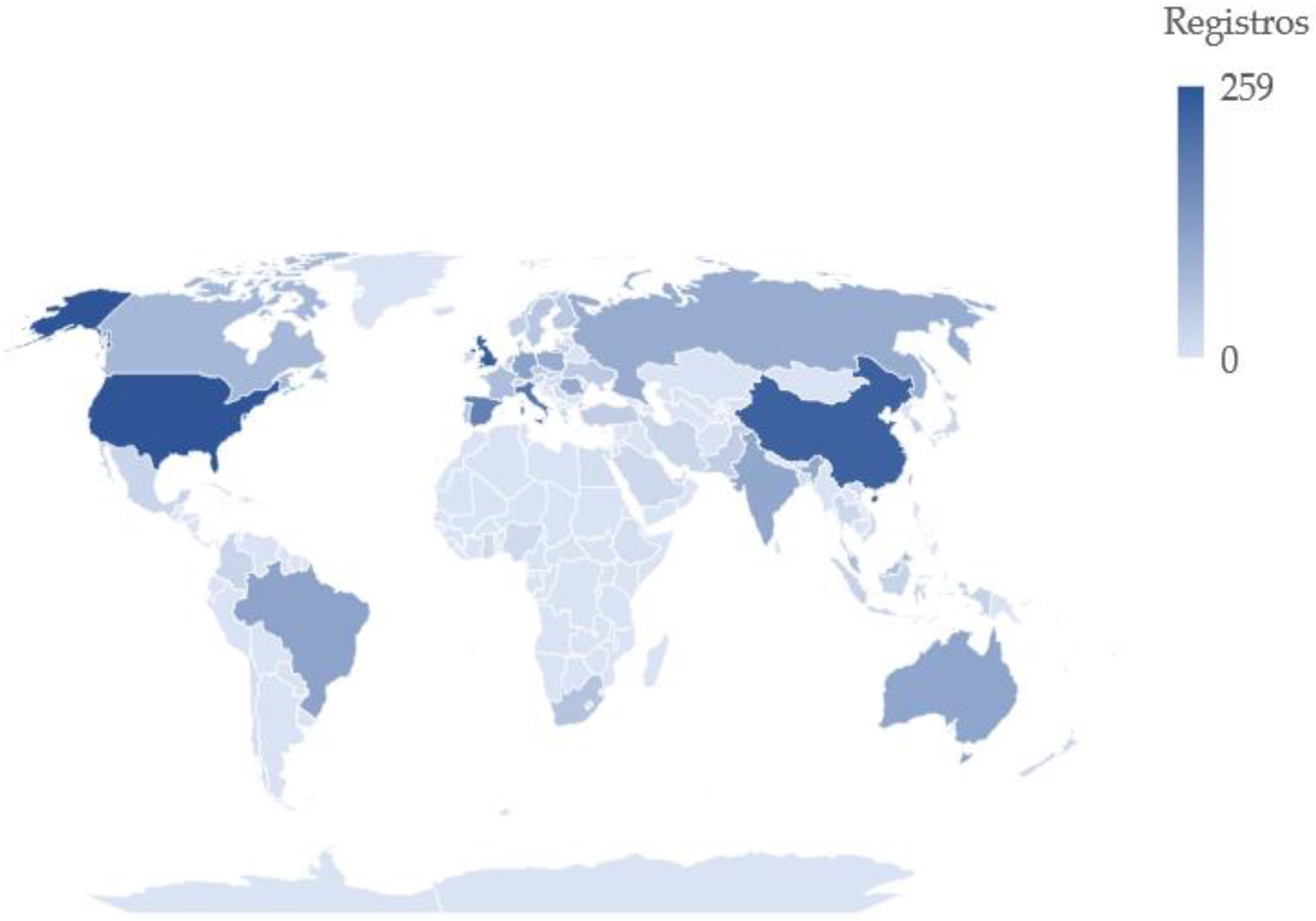
| WOS Categories | Records | WOS Categories | Records | ||
|---|---|---|---|---|---|
| 1 | Environmental Sciences | 1042 | 16 | Ecology | 21 |
| 2 | Green Sustainable Science Technology | 853 | 17 | Computer Science Interdisciplinary Applications | 19 |
| 3 | Business | 751 | 18 | Hospitality Leisure Sport Tourism | 18 |
| 4 | Environmental Studies | 721 | 19 | Energy Fuels | 17 |
| 5 | Management | 715 | 20 | Public Environmental Occupational Health | 17 |
| 6 | Economics | 409 | 21 | Computer Science Information Systems | 15 |
| 7 | Engineering Environmental | 282 | 22 | Social Sciences Interdisciplinary | 15 |
| 8 | Business Finance | 66 | 23 | Psychology Applied | 14 |
| 9 | Regional Urban Planning | 53 | 24 | Water Resources | 14 |
| 10 | Ethics | 48 | 25 | International Relations | 13 |
| 11 | Operations Research Management Science | 32 | 26 | Geography | 11 |
| 12 | Education Educational Research | 31 | 27 | Agricultural Economics Policy | 10 |
| 13 | Engineering Industrial | 31 | 28 | Transportation | 10 |
| 14 | Development Studies | 29 | 29 | Forestry | 9 |
| 15 | Information Science Library Science | 26 | 30 | Law | 9 |
| Keyword | Frequency | Cluster |
|---|---|---|
| Sustainability | 426 | 1 |
| Sustainable development | 402 | 1 |
| Sustainable Development Goals | 268 | 6 |
| Management | 264 | 1 |
| Performance | 263 | 2 |
| Innovation | 228 | 3 |
| Impact | 163 | 3 |
| Business | 146 | 6 |
| Corporate Social Responsibility | 140 | 5 |
| Framework | 133 | 3 |
| Model | 127 | 2 |
| Governance | 119 | 6 |
| CSR | 111 | 5 |
| SDGs | 102 | 6 |
| Entrepreneurship | 91 | 4 |
| Corporate Sustainability | 90 | 5 |
| Strategy | 90 | 2 |
| Challenges | 83 | 4 |
| Circular economy | 78 | 2 |
| Implementation | 50 | 2 |
| Author | Records | Citations * | Ratio | Institution | Country |
|---|---|---|---|---|---|
| Assunta Di Vaio | 10 | 227 | 22.7 | Parthenope University Naples | Italy |
| Roberta Costa | 8 | 184 | 23.0 | University of Rome Tor Vergata | Italy |
| Armando Calabrese | 7 | 202 | 28.9 | University of Rome Tor Vergata | Italy |
| Rohail Hassan | 7 | 217 | 31.0 | Universiti Utara Malaysia | Malaysia |
| Walter Leal | 7 | 312 | 44.6 | Manchester Metropolitan University | United Kingdom |
| Marga Hoek | 6 | 6 | 1.0 | Johannes Gutenberg University of Mainz | Germany |
| Liu Y | 6 | 126 | 21.0 | Linkoping University | Sweden |
| Sachin Kumar Mangla | 6 | 334 | 55.7 | Jindal Global University | India |
| Osvaldo Luiz Goncalves Quelhas | 6 | 302 | 50.3 | Universidade Federal Fluminense | Brazil |
| Rob Van Tulder | 6 | 238 | 39.7 | Erasmus University Rotterdam | The Netherlands |
| Anthony Alexander | 5 | 96 | 19.2 | University of Sussex | United Kingdom |
| Rosley Anholon | 5 | 109 | 21.8 | Universidade Estadual de Campinas | Brazil |
| Alexander Brem | 5 | 117 | 23.4 | University of Stuttgart | Germany |
| Thomas Dyllick | 5 | 158 | 31.6 | University of St Gallen | Switzerland |
| Isabel Maria Garcia-Sánchez | 5 | 122 | 24.4 | University of Salamanca | Spain |
| Nathan Levialdi Ghiron | 5 | 58 | 11.6 | University of Rome Tor Vergata | Italy |
| Lea Iaia | 5 | 14 | 2.8 | University of Chieti-Pescara | Italy |
| Ivan Montiel | 5 | 57 | 11.4 | Loyola Marymount University | United States |
| Rosa Palladino | 5 | 216 | 43.2 | University of Milano-Bicocca | Italy |
| Izabela Simon Rampasso | 5 | 109 | 21.8 | Universidad Católica del Norte | Chile |
| Gilberto Santos | 5 | 21 | 4.2 | Polytechnic Institute Cavado Ave | Portugal |
| Demetris Vrontis | 5 | 50 | 10.0 | University of Nicosia | Cyprus |
| Zhu L | 5 | 95 | 19.0 | Wuhan Textile University | China |
| Jaffar Abbas | 4 | 13 | 3.3 | Shanghai Jiao Tong University | China |
| Beatriz Aibar-Guzmán | 4 | 104 | 26.0 | University of Santiago De Compostela | Spain |
| Andrew Alola | 4 | 68 | 17.0 | University of Vaasa | Finland |
| Stefano Amelio | 4 | 8 | 2.0 | University of Insubria | Italy |
| Surajit Bag | 4 | 64 | 16.0 | University of Johannesburg | South Africa |
| Francesco De Luca | 4 | 15 | 3.8 | University of Chieti-Pescara | Italy |
| Patrizia Gazzola | 4 | 110 | 27.5 | University of Insubria | Italy |
| Institutions | Records | Region |
|---|---|---|
| Bucharest University of Economic Studies | 44 | Romania |
| Indian Institutes of Technology | 38 | India |
| Ministry of Education Science of Ukraine | 34 | Ukraine |
| Universidade de Sao Paulo | 24 | Brazil |
| University of London | 21 | United Kingdom |
| Parthenope University Naples | 19 | Italy |
| University of Rome Tor Vergata | 17 | Italy |
| University of Southern Denmark | 17 | Denmark |
| Erasmus University Rotterdam | 15 | The Netherlands |
| Technical University Czestochowa | 15 | Poland |
| Tecnologico de Monterrey | 14 | Mexico |
| University of Johannesburg | 14 | South Africa |
| Monash University | 13 | Australia |
| University Vollege London | 13 | United Kingdom |
| University of Oxford | 13 | United Kingdom |
| University of Zilina | 13 | Slovakia |
| HSE University | 12 | Russia |
| Universidade de Lisboa | 12 | Portugal |
| Universiti Utara Malaysia | 12 | Malaysia |
| University of Sussex | 12 | United Kingdom |
| Warsaw School of Economics | 12 | Poland |
| Copenhagen Business School | 11 | Denmark |
| Norwegian University of Science Technology | 11 | Norway |
| Peter the Great St.Petersburg Polytechnic University | 11 | Russia |
| University of Erlangen Nuremberg | 11 | Germany |
| University of Granada | 11 | Spain |
| Josip Juraj Strossmayer University of Osijek | 11 | Croatia |
| University of Queensland | 11 | Australia |
| Journals | Records | Highest 2021 JIF Quartile | Publishing Houses |
|---|---|---|---|
| Sustainability | 504 | Q2 | MDPI |
| Journal of Cleaner Production | 217 | Q1 | Elsevier |
| Business Strategy and the Environment | 59 | Q1 | Wiley |
| Corporate Social Responsibility and Environmental Management | 37 | Q1 | Wiley |
| Journal of Business Ethics | 34 | Q1 | Springer |
| International Journal of Management Education | 22 | Q1 | Elsevier |
| Environment Development and Sustainability | 19 | Q2 | Springer |
| European Journal of Sustainable Development | 19 | n/d | European Center Sustainable Development |
| Technological Forecasting and Social Change | 18 | Q1 | Elsevier |
| Journal of Environmental Management | 17 | Q1 | Elsevier |
| Sustainability Accounting Management and Policy Journal | 16 | Q2 | Emerald |
| Environmental Science and Pollution Research | 15 | Q2 | Springer |
| International Journal of Environmental Research and Public Health | 15 | Q2 | MDPI |
| Business Strategy and Development | 14 | Q3 | Wiley |
| Corporate Governance the International Journal of Business in Society | 14 | n/d | Emerald |
| Resources Conservation and Recycling | 14 | Q1 | Elsevier |
| Economic Research Ekonomska Istrazivanja | 13 | Q2 | Routledge |
| Journal of Business Research | 13 | Q1 | Elsevier |
| Frontiers in Environmental Science | 12 | Q2 | Frontiers |
| Sustainability Science | 12 | Q1 | Springer |
| Amfiteatru Economic | 11 | Q2 | Editura |
| International Journal of Life Cycle Assessment | 11 | Q2 | Springer |
| Social Responsibility Journal | 11 | n/d | Emerald |
| Baltic Journal of Economic Studies | 10 | n/d | Routledge |
| Ecological Economics | 10 | Q1 | Elsevier |
| Energy Policy | 10 | Q1 | Elsevier |
| Journal of International Business Policy | 10 | Q1 | Springer |
| Economies | 9 | n/d | MDPI |
| Forest Policy And Economics | 9 | Q1 | Elsevier |
Disclaimer/Publisher’s Note: The statements, opinions and data contained in all publications are solely those of the individual author(s) and contributor(s) and not of MDPI and/or the editor(s). MDPI and/or the editor(s) disclaim responsibility for any injury to people or property resulting from any ideas, methods, instructions or products referred to in the content. |
© 2023 by the authors. Licensee MDPI, Basel, Switzerland. This article is an open access article distributed under the terms and conditions of the Creative Commons Attribution (CC BY) license (https://creativecommons.org/licenses/by/4.0/).
Share and Cite
Martínez-Falcó, J.; Marco-Lajara, B.; Sánchez-García, E.; Millan-Tudela, L.A. Sustainable Development Goals in the Business Sphere: A Bibliometric Review. Sustainability 2023, 15, 5075. https://doi.org/10.3390/su15065075
Martínez-Falcó J, Marco-Lajara B, Sánchez-García E, Millan-Tudela LA. Sustainable Development Goals in the Business Sphere: A Bibliometric Review. Sustainability. 2023; 15(6):5075. https://doi.org/10.3390/su15065075
Chicago/Turabian StyleMartínez-Falcó, Javier, Bartolomé Marco-Lajara, Eduardo Sánchez-García, and Luis A. Millan-Tudela. 2023. "Sustainable Development Goals in the Business Sphere: A Bibliometric Review" Sustainability 15, no. 6: 5075. https://doi.org/10.3390/su15065075
APA StyleMartínez-Falcó, J., Marco-Lajara, B., Sánchez-García, E., & Millan-Tudela, L. A. (2023). Sustainable Development Goals in the Business Sphere: A Bibliometric Review. Sustainability, 15(6), 5075. https://doi.org/10.3390/su15065075







